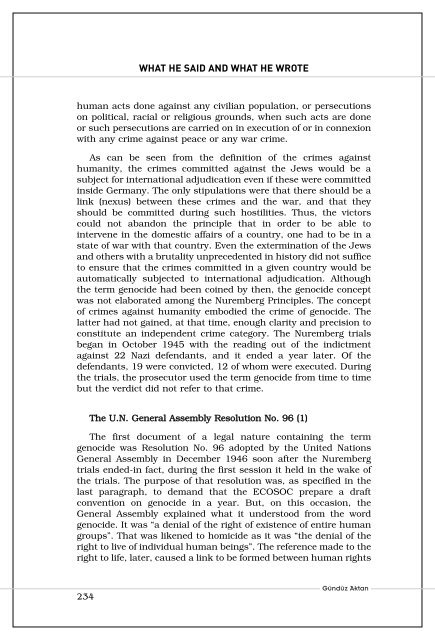gunduz-aktan-kitap-soyledikleri-ve-yazdiklari
gunduz-aktan-kitap-soyledikleri-ve-yazdiklari
gunduz-aktan-kitap-soyledikleri-ve-yazdiklari
Create successful ePaper yourself
Turn your PDF publications into a flip-book with our unique Google optimized e-Paper software.
WHAT HE SAID AND WHAT HE WROTE<br />
human acts done against any civilian population, or persecutions<br />
on political, racial or religious grounds, when such acts are done<br />
or such persecutions are carried on in execution of or in connexion<br />
with any crime against peace or any war crime.<br />
As can be seen from the definition of the crimes against<br />
humanity, the crimes committed against the Jews would be a<br />
subject for international adjudication e<strong>ve</strong>n if these were committed<br />
inside Germany. The only stipulations were that there should be a<br />
link (nexus) between these crimes and the war, and that they<br />
should be committed during such hostilities. Thus, the victors<br />
could not abandon the principle that in order to be able to<br />
inter<strong>ve</strong>ne in the domestic affairs of a country, one had to be in a<br />
state of war with that country. E<strong>ve</strong>n the extermination of the Jews<br />
and others with a brutality unprecedented in history did not suffice<br />
to ensure that the crimes committed in a gi<strong>ve</strong>n country would be<br />
automatically subjected to international adjudication. Although<br />
the term genocide had been coined by then, the genocide concept<br />
was not elaborated among the Nuremberg Principles. The concept<br />
of crimes against humanity embodied the crime of genocide. The<br />
latter had not gained, at that time, enough clarity and precision to<br />
constitute an independent crime category. The Nuremberg trials<br />
began in October 1945 with the reading out of the indictment<br />
against 22 Nazi defendants, and it ended a year later. Of the<br />
defendants, 19 were convicted, 12 of whom were executed. During<br />
the trials, the prosecutor used the term genocide from time to time<br />
but the <strong>ve</strong>rdict did not refer to that crime.<br />
The U.N. General Assembly Resolution No. 96 (1)<br />
The first document of a legal nature containing the term<br />
genocide was Resolution No. 96 adopted by the United Nations<br />
General Assembly in December 1946 soon after the Nuremberg<br />
trials ended-in fact, during the first session it held in the wake of<br />
the trials. The purpose of that resolution was, as specified in the<br />
last paragraph, to demand that the ECOSOC prepare a draft<br />
con<strong>ve</strong>ntion on genocide in a year. But, on this occasion, the<br />
General Assembly explained what it understood from the word<br />
genocide. It was “a denial of the right of existence of entire human<br />
groups”. That was likened to homicide as it was “the denial of the<br />
right to li<strong>ve</strong> of individual human beings”. The reference made to the<br />
right to life, later, caused a link to be formed between human rights<br />
234<br />
Gündüz Aktan



